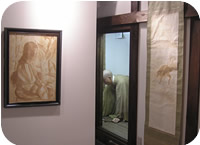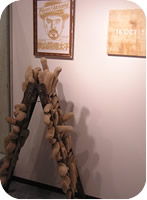|
 Thank
you for visiting the official website of the Museum
of Soy Sauce Art. We cannot hide our feelings of joy
and cannot help but impressed by your spiritual nobility
of actively learning for the sake of your own cultivation. Thank
you for visiting the official website of the Museum
of Soy Sauce Art. We cannot hide our feelings of joy
and cannot help but impressed by your spiritual nobility
of actively learning for the sake of your own cultivation.
Nowadays people talk much about the
importance of spiritual richness, in addition to that
of material richness, and we strongly believe that soy
sauce can offer the former kind of richness. We have
no doubt that the creative exploration of the potential
of soy sauce art can offer the solid foundation of real
spiritual richness in art.
Soy sauce is said to have been brought
back from China by Kobo Daishi (Kukai), and as the discovery
of its excellence as a drawing material, Kobo Daishi
and his disciples opened up the history of soy sauce
art. People's opinions about it, however, have changed
again and again, as the history develops.
 In
Momoyama period (16th century), there emerged a lot
of prominent soy sauce painters, and soy sauce culture
blossomed. At that time, people did soy sauce paintings
on sliding doors of great shrines, some of which are
preserved even today. However, in Edo period when a
new technique Ukiyo-e appeared, soy sauce art became
less and less popular, and was gradually abandoned. In
Momoyama period (16th century), there emerged a lot
of prominent soy sauce painters, and soy sauce culture
blossomed. At that time, people did soy sauce paintings
on sliding doors of great shrines, some of which are
preserved even today. However, in Edo period when a
new technique Ukiyo-e appeared, soy sauce art became
less and less popular, and was gradually abandoned.
In Meiji period, Ernest Fenollosa and Tenshin Okakura
reevaluated soy sauce art, and it merged with the forthcoming
western oil painting technique, which brought about
a new stage to its history. Eminent artists wrestled
with its reformation, and the leading status of soy
sauce art was now established in Japanese art world.
However, using the end of WWII as
a turning point, soy sauce art was about to be forgotten
again. Most artists shunned it as authoritarian remains
of former times. Yet some of the young artists, who
knew the real charm of soy sauce paintings, started
to adapt it into contemporary art, in order to avoid
its extinction on political grounds of the time.
The Sanuki Museum of Soy Sauce Art
exhibits the overview of outstanding works from each
period, in light of all its changing historical developments.
It is our strong conviction that
traditional soy sauce drawings will surely be a novel
instrument of art, which connects Japan and other Asian
countries, as well as the rest of the world of the 21st
century. We hope that, in the near future, we can establish
a full-scale museum of soy sauce art, and be able to
communicate the greatness of soy sauce drawings to as
many people as possible.
Director of the Sanuki
Museum of Soy Sauce Art
TSUYOSHI OZAWA
Profile
|
